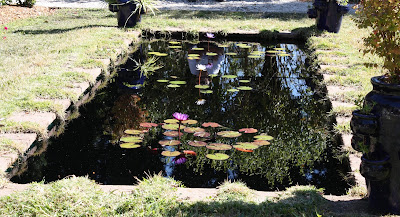Once through the main gate, the first thing you see is this fountain. Doesn't look like much to me but then...it's been there for more than 100 years.
Looking past the fountain, there are remnants of the original pier.
This path follows the river along the property line.
Thomas Edison purchased (I think) 13 acres in 1885 and drew a pencil sketch of how he wanted the property to look. The lumber for the two post-and-beam houses was pre-cut in Maine and transported by ship to this site. This estate is named Seminole Lodge.
This is the main house; there is a guest house next door which is a duplicate floor plan, in reverse. The two structures are connected by a pergola.
The Edisons wintered here until 1947, when Mrs. Mina Edison (Thomas' second wife) deeded the property to the City of Fort Myers. All of the furnishings in these two structures belonged to the Edisons. I think that's very cool!
 |
| The porches are full of wicker furniture. |
 |
| Library |
 |
| The view from the back porch |
 |
| Living Room |
 |
| Master Bedroom |
 |
| Dining Room |
 |
| Kitchen/Pantry |
These are called electroliers the there were many different designs...
This was the largest of the three tarpon fish that are mounted on the porch and I believe they were caught by the Edisons.
Thomas Edison constructed a pool in 1910 built from Edison Portland cement, one of the first residential pools in SW Florida. In 1928 he added a Tea House and enlarged the bath house.
 |
| Tea Garden fountain |
Edison's original 1886 laboratory was moved in 1928 from here to Henry Ford's museum in Michigan. Ford agreed to build another study in its place.
Mrs. Edison commissioned Ellen Biddle Shipman, a renowned landscape architect, to design an area behind the study to include flowers and a small pool to reflect the moonlight. I think I need one of these!
There is also a caretaker's house considered to be one of the oldest standing structures in Fort Myers.
The 4 acre property located next door was purchased by Henry Ford in 1916 and is called The Mangoes. A double row of mango trees was planted along the McGregor Blvd. fence line spanning both properties.
This statue of Henry Ford is located next to the fence separating the properties.Unfortunately, when the Ford's decided they were no longer going to winter here, they sold all the furnishings, so what's here is correct for the time period but didn't belong to the Ford's.
 |
| Secretary's Bedroom |
 |
| Ford Estate Bedroom |
 |
| Living Room |
 |
| Dining Room |
 |
| Pantry |
 |
| Master Bedroom |
After purchasing the property from Henry Ford in 1947, the Biggar family added a garage building where antique vehicles are on display.
 |
| 1929 Ford Model A |
 |
| 1921 Ford Model T square cab pickup truck |
We picked up some beverages and candy snacks at the Cottage Shoppe, which was originally used as Ford's garage and caretaker's residence. We sat on a bench next to the river and enjoyed the scenery.
 |
| The Caloosahatchee River |
 |
| Pano shot from our bench |
These stones were given to the Edison's by their friends and date back to 1930.
This historic property is located on both sides of McGregor Blvd. While the two living estates are located on the river side, the Botanical Research Laboratory is located across the street.
The Edison Botanic Research Corporation was founded in 1927 by Edison, Ford and Harvey Firestone as a result of their concern regarding America's dependence on foreign sources of rubber for industrial use.
The laboratory was built in 1928 and was operational until 1936 (five years after Edison's death). "The layout of the interior contained a chemical processing area, machine shop, grinding room, office and dark room".
Historical documents indicate that the banyan tree towering over this statue of Edison was planted in 1927 and is one of the largest in the Continental US.
This type of tree produces a white milky sap (latex) that can be used to create rubber. Edison tested over 17,000 plant samples in his rubber research.
There is also a museum store, heritage garden and garden shoppe. The garden shoppe hosts the statue of Edison's second wife, Mina Miller Edison.
If I remember correctly, this monster is a Kapok tree.
Bill is dwarfed by the trunk! It kind of looks like an elephant's foot.
It was nice to check this off my bucket list and it's a nice place to visit but I don't think it's a place I would need to visit again, unless we have company that's interested.
Thanks for stopping by...
;o)


































No comments:
Post a Comment